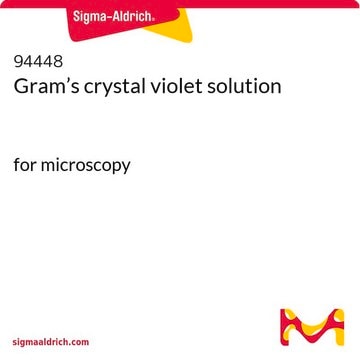61135
Crystal Violet
for microscopy (Bact., Bot., Hist., Vit.), indicator (pH 0.1-2.0)
Synonym(s):
Basic Violet 3, Gentian Violet, Hexamethylpararosaniline chloride, Methyl Violet 10B
About This Item
Recommended Products
grade
for microscopy (Bact., Bot., Hist., Vit.)
indicator (pH 0.1-2.0)
Quality Level
form
powder
color
green to very dark green
visual transition interval
0.1-2.0, yellow-green to blue-violet
mp
205 °C (dec.) (lit.)
density
1.190 g/cm3
ε (extinction coefficient)
≥1750 at 585-595 nm in water
suitability
suitable for microscopy (Bact., Bot., Hist., Vit.)
antibiotic activity spectrum
fungi
application(s)
diagnostic assay manufacturing
hematology
histology
Mode of action
cell membrane | interferes
enzyme | inhibits
storage temp.
room temp
SMILES string
[Cl-].CN(C)c1ccc(cc1)\C(c2ccc(cc2)N(C)C)=C3/C=C\C(C=C3)=[N+](/C)C
InChI
1S/C25H30N3.ClH/c1-26(2)22-13-7-19(8-14-22)25(20-9-15-23(16-10-20)27(3)4)21-11-17-24(18-12-21)28(5)6;/h7-18H,1-6H3;1H/q+1;/p-1
InChI key
ZXJXZNDDNMQXFV-UHFFFAOYSA-M
Looking for similar products? Visit Product Comparison Guide
Related Categories
General description
Application
- Crystal violet is mainly used in Gram staining and its variants, and for staining amyloid, bacterial components, and vascular plant tissues.
- It is used in polychrome staining of epoxy resin sections, viability staining of cultured neurons, and confocal optical sectioning to analyze meiotic structures.
- It is also employed in the acridine orange-crystal violet staining of intracellular bacteria, microsporidian spores, and cytological smears.
Biochem/physiol Actions
Principle
Signal Word
Danger
Hazard Statements
Precautionary Statements
Hazard Classifications
Acute Tox. 4 Oral - Aquatic Acute 1 - Aquatic Chronic 1 - Carc. 1B - Eye Dam. 1 - Muta. 2
Storage Class Code
6.1C - Combustible acute toxic Cat.3 / toxic compounds or compounds which causing chronic effects
WGK
WGK 3
Flash Point(F)
Not applicable
Flash Point(C)
Not applicable
Personal Protective Equipment
Choose from one of the most recent versions:
Already Own This Product?
Find documentation for the products that you have recently purchased in the Document Library.
Customers Also Viewed
Our team of scientists has experience in all areas of research including Life Science, Material Science, Chemical Synthesis, Chromatography, Analytical and many others.
Contact Technical Service








